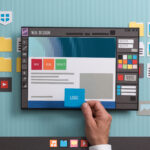Defining Design Leadership : 6 categories & traits of a design leader

The faults in our definition of design leadership
If you go and search for the term “leadership” on Amazon, a whopping 50,000+ results pop up. The word “leadership” is searched more than a million times on Google every month, in the US alone. And it is one of the most common professional traits expected in candidates applying for jobs. We love leaders. Well, if not love, let’s just say most of us respect the power they command. Both in and outside professional realms, we just can’t get enough of leaders, pioneers, and superheroes, leading our way to infinity & beyond.
.jpg)
All this hype & commotion around the term “leader”, yet in most cases it remains a poorly defined concept, both as a term overly-thrown-around-the-boardroom and an incoherent medley of mixed-up expectations. And in the absence of a well-defined definition, designers, design leaders, & designer-leaders-in-the-making, often face the brunt of bludgeoning organizational responsibilities with very little say in the outcomes, results, & impact of design.
So back to square one – how do we define design leadership?
The bad & the good news is – there is no one definition. Bad news because now all your hopes of finding the one true definition of design leadership & what makes a good design leader are dashed. Good news because, as a designer (or design leader) you don’t really have to cage yourself inside a box.
6 types of design leaders: Not all design leaders are created equal
So now that we have established what design leadership isn’t (one restrictive definition), let us explore what design leadership is. From our experience, design leaders come in all sizes, shapes, hues, philosophies, & mantras. Though it’s unfair to strictly categorize them into sharply defined categories, most design leaders fall somewhere within these spectrums –
The Design Evangelist
Pros: Knowledgeable, zealous, strong advocate of design
Cons: “My way or the highway” approach to design leadership
Antidote: Forge stronger communication channels
.gif)
If you know someone who has been a veteran in the design field of the sorts, possessing gargantuan levels of knowledge, with an aura that spells “I was there when it was written”, and is often a preacher/teacher for designers, then it’s highly likely that said person is a “Design Evangelist” kind of leader.
Often seen inspiring the design community with a deep fervor for everything design & championing the value of design to the unaware or the opposed, design evangelists often fall prey to aggression, rigidity, and arrogance, if left unchecked. Their biggest strength could pave the way for their biggest downfall, thus it’s essential for the evangelist category of designers to temper down their intensity with open & honest communication channels with their teams, welcoming newer perspectives.
The Design Visionary
Pros: Excel at the macro & micro vision of the project
Cons: Easily untethered, unrealistic, creative overindulgence
Antidote: Learn to let go
.gif)
Those with a visionary approach to design leadership are capable of zooming in & out of the design challenge, process, systems, etc with utmost accuracy & precision, making them the real MVPs when it comes to charting a definitive path from problem to solution. More democratic than their evangelist counterparts, they believe in asking the right questions to their team, in terms of “how do we find the best solution?” and “how do we get there”.
Best at defining goals, lending great structure to the organization, & setting quality standards for the team, design visionaries come with relatively zero shortcomings. Except for one. At times, they tend to go a bit overboard with their vision which can turn unrealistic & disillusioned pretty quickly. Unwillingness & incapability to let go of ideas they have fallen desperately in love with, they stand a chance of misdirecting their team’s strengths towards a lofty goal. What might help them is the strength to let go of some ideas & visions that could have negative repercussions on the team.
The Buddy Leader
Pros: “You’ve got a friend in me” approach to leadership
Cons: Perceived as lacking in authority
Antidote: Get some real leadership experience
.gif)
“I am not your boss, we don’t believe in hierarchies, I am your friend”. Many organizations & leaders love saying this. Only, a buddy-kind of design leader truly acts on it. Owing to their friendly demeanor & a diversity of roles to account for in their resume, buddy leaders often climb up high in the leadership ladder, without having much of any “real leadership qualities” (read: inability to hold people accountable, giving negative feedback, having authority over team, scope, a vision of the project).
Buddy folks are the biggest advocates of their people (peeps, buddies, what have you), acting more like peers & less like leaders with other designers. Though their amiable nature enables thriving collaborations & honest exchange of ideas because they create a huge safety net, they fail to solve team conflicts, give stronger feedback, address bad performance, & point out areas of improvement. When it comes to tough decision-making, buddy leaders fail, leading to flagrant disrespect & loss of authority over the team.
The Democratic Leader
Pros: Everyone has to feel “heard”
Cons: “Everyone” has to feel heard
Antidote: Stop stopping for everything
.gif)
“Of the people, by the people, for the people” system of governance has by far been the most effective, thanks to the freedom & rights it gives to the people within the system. A democratic leader is highly aware of the impact design decisions, both big & small, have on the outcome. And thus is created a culture of making everyone voice their opinion, and having everything seen, felt, & heard. On the bright side, the team feels valued.
And every action is an aggregate thought of the entire team.
On the dark side, hanging onto every little decision & thought inhibits speed. Everything becomes painfully long-winded. Frustrations rise. Indecision increases. The countermeasure for this is to analyze which decisions are worth a halt, and which ones can be left alone at the discretion of the team lead.
The Pixel Perfect Leader
Pros: High-caliber output
Cons: Quality triumphs team needs
Antidote: Stay away from micromanagement

Unmatched precision, skills, & technical expertise is the hallmark of the Pixel Perfect Leader, who prioritizes (& at times go overboard with the obsession) for technical “correct-ness” of the tasks. Admired for their deep design expertise, pixel-perfect leaders often resort to micromanaging their teams, if the team falls behind in keeping up with the benchmark set by the leader.
The downside of this approach is that the focus is shifted away from experimenting & doing great work, to avoiding mistakes. Low morale, burnout, & fear of trying out something new becomes the team mantra. However, if pixel-pushing leaders are able to don a more people-centric & empathetic approach to leadership, they hold the potential to scale great heights as a design leader, who not only raises the quality standards of their team but also boosts morale, productivity, & personal fulfillment of their team.
The Ultimate Coach
Pros: Holistic team development
Cons: May not be a good fit for a senior design team
Antidote: Find the best organizational fit
.gif)
For the Ultimate coach, a mentor-kind of design leader, leadership is all about the people they are leading – what are their fears? Aspirations? Aim? Vision? They invest their entire design leadership skills in developing people. The team thrives under such leadership with constructive feedback, open & honest communication channels, and lots of support & encouragement.
The only possible drawback of this otherwise almost perfect form of design leadership is that in teams with only senior designers, who don’t need much help in realizing their dreams, career aspirations, & so on, the constant guidance can be a hindrance to progress. Since, the ultimate coach type of design leader is so focused on the holistic development of their teams, it’s essential to understand core organizational needs before hiring a design lead. Does the company need a mentor to comprehensively build a team from the ground up? If yes, the coach kind of design leader is the way to go.
6 Design leadership skills every design leader must possess
Empathy
“People ignore designs that ignores people” – Frank Chimero

Before anything, a design leader has to be a champion for the users. Walking a mile (or 500) in the shoes of the end user is something a design leader has to nurture right from the beginning of their design journey. The ability to design for a diverse range of users & use cases comes from the ability to understand the needs, wants, & pain points of the users. And it doesn’t happen with day #1. It’s a skill that takes time to develop.
That comes with tons of user research sessions, usability testing, & a complete immersion into the environment of the user. That is when you begin designing experiences that alleviate pain, maximize gains, & add value to the users’ lives. This is not just a stepping stone for any designer starting out, but a trait that must become hardwired with your DNA, in order to evolve into a design leader.
Strategic thinking
“The essence of strategy is choosing what not to do.” – Micheal Porter

Strategy is where user needs & business needs overlap – the sweet spot that forms the basis of all design decisions. When we talk about strategic thinking, we talk about aligning the sum total of your user’s experience at every touch point – with those of your client’s company guidelines. Strategic thinking is an essential element of the design leader’s (& designer’s) artillery as a strategic mindset paves the path for better user experiences, better client relationships, & seamless collaboration between design team/s & business stakeholders.
Sun Tzu, in Art of War, contends “Ponder & deliberate before you make a move”. Be it the battlefield or a board room meeting with the stakeholders, a design leader’s core strength is brought into action when they are able to coordinate a nexus between business strategy & design thinking. Defining scope, making clear trade-offs between user needs & company’s vision, and formulating a foolproof plan are some of the major goals a design leader has to focus on when thinking strategically.
Planning
“Failing to plan is planning to fail” – Winston Churchill

Plan. Everything starts (or at least should start) with a plan. Be it robbing a bank or building the next skyscraper, charting down a proper blueprint that defines roles, tasks, & course of action is what makes (or breaks) the project at hand. A design leader knows that before diving head-on into the ocean of project tasks, it’s essential to translate all of that empathy, strategic thinking, and numerous meetings with the stakeholders into a beautiful, effective, & sustainable plan.
But planning is not as simple as making a simple “to-do list”. To be good, nay great, at planning, a design leader has to collaborate & coordinate across a diverse array of methods, tools, scenarios, talent, skills, & expertise of their team.
- From project POV, they should have clearly defined scope, time, & expectations.
- From product/services POV, a design leader must plan keeping in mind various departments, touchpoints, etc.
- From team POV, a lot of planning has to go in bringing together the right mix of talent, experience, and expertise keeping mind the unique demands of the project
- From individual player POV, a design leader is someone who is able to understand each team member’s strengths, aspirations, motivations, attitude, & unique perspectives thus aligning their personal goals with professional ones.
Mentoring
“Mentoring is a brain to pick, an ear to listen, and a push in the right direction” – John C. Crosby

Yoda, Mr. Miyagi, Prof. Dumbledore, Gandalf, Mary Poppins, John Keating – Why do these fictional characters tend to remain etched in our memories? Each of them was a great mentor, aka, someone who saw potential & hopes (tons of it!) in seemingly average people & was able to unleash the greatness hidden within them by guiding them through the right path.
As a design leader, it’s important to know that most designers in your team (if not all) are consciously or subconsciously looking for The One mentor who can launch them to greatness. The right mentor sees what you are and what you can become, and pushes you beyond your comfort zone in the direction you ought to go. In the field of design, a design leader acts as a mentor when they
- Provide honest & constructive feedback
- Enable designers to grow & excel at their craft
- Molds design leaders of the future
- Helps designers realize their full potential & purpose
- Empowers designers to build their technical, soft, & leadership skills
- Enhance your networking
- Enable you to discover new opportunities & build newer perspectives
Versatility
“Versatility is an extra string to a player’s bow.” – Alex Chamberlain

Designers with just one or (a few key) strengths seldom make it to the higher ranks. Because design leadership itself is such a complex role & there are so many different varieties of design leaders, it’s impossible to have someone lead a design team/s to paths of glory without being versatile. And it’s not just the variety of skills that we are talking about when we talk about design leaders & versatility.
We mean the ability to switch between different projects with different scopes, responsibilities, & functions, and the ability to switch between different “modes” without losing sight of the big picture. The more versatile a design leader is, the higher is their flexibility in switching between
- Idea Mode – Focusing on creative solutions, brainstorming on new ideas, thinking of new possibilities & perspectives, a complete indulgence in finding creative solutions.
- Input Mode – The ability to take in heaps of information without judging, interpreting, dismissing, accepting, & entertaining – a quiet zen mode of accepting things how they are.
- Work mode – Pulling up your sleeves & getting into solution mode by strictly adhering to quality standards.
Vision
“Vision is the art of seeing what’s invisible”- Jonathan Swift
.jpg)
Devising a unique narrative that not only gives all the strategic thinking & planning a tangible form but also provides the one true guiding star for the entire team/organization to look up to is what having a vision means. This is the one trait that stands out from the rest. The vision lays a strong foundation for all the strategic thinking, planning, and doing. A design leader with a clear vision plays the role of a catalyst who stimulates action & inspires teams to work towards their passion, with a purpose. And it’s no surprise that this trait is the toughest to master.
Spreading your vision accurately to every rung of the hierarchy means taking into account strategic thinking and tactical planning and communicating it effectively so that every team member is inspired, engaged, & works towards a common shared goal. To be a visionary leader means to master a wide range of skills including – communication, collaboration, adaptability, resilience, and not to mention the above mentioned qualities of – empathy, strategic thinking, planning, & versatility.
Bonus: Reading list for design leaders
The leap from a design practitioner to a design leader can be a tough one. Doing the same things over and over again and expecting different results is the textbook definition of insanity. If you need to be something you have never been before, you have to do something that you have never done before. For those senior designers hoping to one day evolve into a design leader, unlearning & learning is the first step. Here’s a handpicked reading list for something as complex and nuanced as design leadership –
.jpg)
Find purpose, creativity, dignity, & meaning in every aspect of your life – Zen and the Art of Making a Living: A Practical Guide to Creative Career Design
Strike the right balance between opposing inclinations & odd juxtapositions as a design leader– The Dichotomy of Leadership
Communicating the right thing, the right way, to the right people – Leadership Is Language: The Hidden Power of What You Say and What You Don’t
Strategies & 5 strength-based leadership traits for leading people towards a better future– Strengths Based Leadership : Great Leaders, Teams, and Why People Follow
One of the best-selling leadership books of all time– The 21 Irrefutable Laws of Leadership : Follow Them and People Will Follow You
Lessons in creative leadership & inspiration from the man who shaped Pixar -Creativity, Inc.: Overcoming The Unseen Forces That Stand In The Way Of True Inspiration
How the right leadership can turn around any organization’s fate – The Ride of a Lifetime: Lessons in Creative Leadership from 15 Years as CEO of the Walt Disney Company
Living a life by design, aka, with deliberate choice & hard work – The Leader Within Us: Mindset, Principles, and Tools for a Life by Design
PS: Design Leadership jobs: We are hiring design leaders
NetBramha Studios is looking for a Design Head (10+ yrs experience) who will be responsible for the overall delivery of design projects, growth of the studio, & designers across all levels. Powered with a deep sense of empathy & robust strategic thinking, our ideal candidate is someone who can own the design practice & raise the bar for our design outcomes.
Find the complete job description here
If you are someone who fits these criteria, apply away! Send in your resume and portfolio to careers@netbramha.com. In case you know someone who can be our Design Head, don’t hesitate from sharing their referral. We have a surprise gift for anyone who refers us to a candidate we end up hiring!
Follow our Linkedin page for more details.


